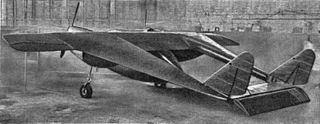
The Percival Gull was a British single-engined monoplane, first flown in 1932. It was successful as a fast company transport, racing aircraft and long-range record breaker. It was developed into the Vega Gull and the Proctor.

The Auster B8 Agricola was a commercially unsuccessful British agricultural aircraft designed for the aerial topdressing market which opened up in New Zealand in the early 1950s.

The Baynes Bat was an experimental glider of the Second World War, designed by L. E. Baynes. It was used to test the tailless design that he had suggested as a means to convert tanks into temporary gliders so they could be flown into battle.

Leslie Everett Baynes, AFRAeS was an English aeronautical engineer.

The Spartan Cruiser was a 1930s British three-engined transport monoplane for 6 to 10 passengers built by Spartan Aircraft Limited at East Cowes, Isle of Wight. It was a development of the Saro-Percival Mailplane for passenger use.

The Percival Q.6 was a 1930s British communications aircraft built by Percival Aircraft Limited at Luton. Originally, the Percival Q.6 was a civil transport but It was used during the Second World War by the Royal Air Force and Royal Navy as a communications and liaison aircraft. It was a twin-engine, low-wing monoplane with a tailwheel undercarriage.

The de Havilland Gipsy Queen is a British six-cylinder aero engine of 9.2 litres (560 cu in) capacity that was developed in 1936 by the de Havilland Engine Company. It was developed from the de Havilland Gipsy Six for military aircraft use. Produced between 1936 and 1950 Gipsy Queen engines still power vintage de Havilland aircraft types today.

The Percival Proctor is a British radio trainer and communications aircraft of the Second World War. The Proctor is a single-engined, low-wing monoplane with seating for three or four, depending on the model.

The Percival Merganser was a light, civil transport of the late 1940s. It was a twin-engine, high-wing monoplane of all-metal, stressed skin construction with retractable tricycle undercarriage.

The Miles M.5 Sparrowhawk was a 1930s British single-seat racing and touring monoplane designed by Miles Aircraft Limited.

The Heston Type 1 Phoenix was a 1930s British single-engined five-seat light transport monoplane built by the Heston Aircraft Company Limited.

The Napier-Heston Racer, also known as the Heston Type 5 Racer or Heston High Speed Aircraft J.5, was a British single-seat racing monoplane developed in the 1940s. It was conceived by D. Napier & Son Ltd. and built by the Heston Aircraft Company. The purpose of this aircraft was to attempt a World Air Speed Record. The project was funded by William Morris, 1st Viscount Nuffield.
The Gnosspelius Gull was a 1920s British experimental ultra-light monoplane designed by Major O.T. Gnosspelius and built by Short Brothers at Rochester for the 1923 Lympne light aircraft trials.
Heston Aircraft Company was a British aircraft manufacturer based at Heston Aerodrome, Middlesex, England.

The de Havilland T.K.2 was a British 1930s single-engined monoplane, designed by students of the de Havilland Aeronautical Technical School. It won two races before World War II, and afterwards set a class closed circuit speed record.

The Hordern-Richmond Autoplane was a 1930s British twin engined two seat cabin touring monoplane designed by Edmund Hordern, and constructed by Heston Aircraft Company Ltd.
The Fane F.1/40 was a 1940s British air observation post aircraft design by Captain Gerald Fane's Fane Aircraft Company.

The Carden-Baynes Bee was a 1930s British two-seat aircraft, with twin engines in pusher configuration buried in the wings. The wings rotated for storage. Financial problems limited the Bee to a single flight.

The Willoughby Delta 8, or Delta F was a small twin-engined aerodynamic test bed for a proposed flying wing airliner - the Delta 9. The Delta 8 flew in the United Kingdom for a few months during 1939 before crashing; there were no developments.

The Hafner A.R.III Gyroplane was a British 1930s experimental autogyro designed by Austrian Raoul Hafner, and built by the A.R.III Construction Company at Denham, Buckinghamshire.

















